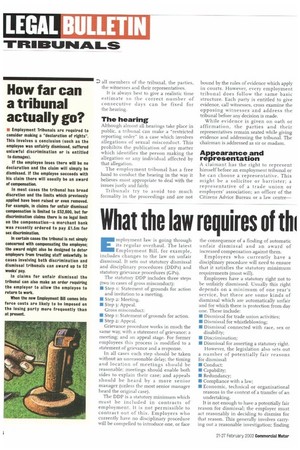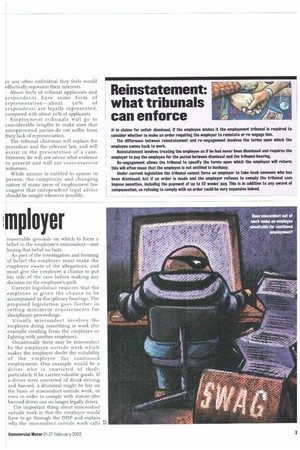Em lo ent tribunals: operation and akeup
Page 25

Page 26

Page 27

If you've noticed an error in this article please click here to report it so we can fix it.
The membership of an employment tribunal is normally a legally qualified chairman and two "lay representatives" from each side of industry.
All three members of the tribunal are selected from separate panels. The chairman is selected from a panel appointed by the Lord Chancellor; he chairman may be full or part time. The lay members are selected from two panels, comprising employers' and employees' representatives.
Lay members
The lay members are appointed and paid by the Secretary of State for Trade and Industry on renewable three-year contracts. They are entitled to: • Question tribunal witnesses; • Take notes of the evidence; • Have an equal vote with the chairman in reaching a decision; • Take part in explaining the reasons for a decision.
Although the lay members are appointed as representatives from both sides of industry, they are required to perform their role as members of the tribunal on an independent and impartial basis. Most tribunal decisions are unanimous.
The chairman
In some cases a tribunal chairman is empowered to deal with the matter on his own. These include:
• Claims for unlawful deductions from wages; • Complaints under the National Minimum Wage Act 1998; • Claims for breach of contract; • Proceedings where the employer doe not contest the case; • Cases where both parties have giver their written consent to a chairmar hearing the case alone.
However, wherever there are significan factual disputes between the parties thi chairman is likely to decide that the casi should be heard by a full tribunal with till lay members.
The chairman is also required to dea with matters which will come up befor. the hearing itself. He can then postpon, the hearing; give directions; decide ai application where the parties are ii written agreement: and deal witl applications made by either party durin: the preparation for the hearing.
For example, the chairman will resolv any dispute between the parties over th disclosure of documentation.
Operation
Employment tribunals operate under rule of procedure set down by Parliamen• requiring tribunals to deal with case "justly". This includes: • Making sure that the two parties are o an equal footing; • Controlling costs; • Dealing with cases in ways which ar proportionate to their complexity; • Making sure the case is dealt wit promptly.
Preparation
In almost all cases the tribunal's directior will require both parties to exchange all relevant documentation, including statements from witnesses who will appear at the hearing. This will happen a week or two in advance.
Cases are normally listed for hearing c a single day unless the parties have agree with the tribunal that more time needed. If the case does not finish with a day it will be adjourned as "part hear( until the next date which is convenient all members of the tribunal, the parties, the witnesses and their representatives.
It is always best to give a realistic time estimate so the correct number of consecutive days can be fixed for the hearing.
The hearing
Although almost all hearings take place in public, a tribunal can make a "restricted reporting order" in a case which involves allegations of sexual misconduct. This prohibits the publication of any matter which identifies the person making the allegation or any individual affected by that allegation.
The employment tribunal has a free hand to conduct the hearing in the way it believes most appropriate to deal with the issues justly and fairly.
Tribunals try to avoid too much formality in the proceedings and are not bound by the rules of evidence which apply in courts. However, every employment tribunal does follow the same basic structure. Each party is entitled to give evidence, call witnesses, cross examine the opposing witnesses and address the tribunal before any decision is made.
While evidence is given on oath or affirmation, the parties and their representatives remain seated while giving evidence and addressing the tribunal. The chairman is addressed as sir or madam.
Appearance and representation
A claimant has the right to represent himself before an employment tribunal or he can choose a representative. This might be a solicitor or barrister; a representative of a trade union or employers' association; an officer of the Citizens Advice Bureau or a law centre—
or any other individual they feels would effectively represent their interests.
About Go% of tribunal applicants and fespondents have some form of representation—about 50% of respondents are legally represented, compared with about 30% of applicants.
Employment tribunals will go to considerable lengths to make sure that unrepresented parties do not suffer from their lack of representation.
The tribunal chairman will explain the procedure and the relevant law, and will assist in the presentation of a case. However, he will not advise what evidence to present and will not cross-examine witnesses.
While anyone is entitled to appear in person, the complexity and changing nature of many areas of employment law suggest that independent legal advice should be sought wherever possible.






















































































































































